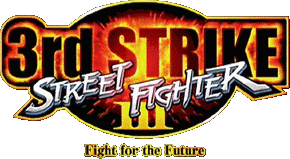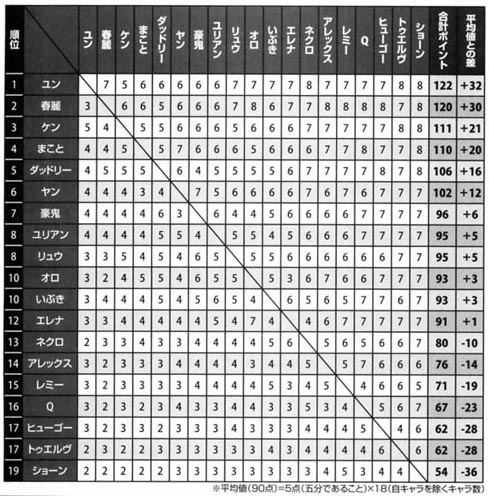Larryhartz (talk | contribs) |
|||
| Line 6: | Line 6: | ||
Home versions of Street fighter 3: 3rd Strike can be found on the Dreamcast, PS2 and Xbox. The Dreamcast version was released in 2000 with slight differences to the arcade version. In 2004, Capcom released 3rd Strike as part of the "Street Fighter Anniversary Collection" for the Xbox and Playstation 2 which also included [[Hyper Street Fighter 2]]. Today, the Playstation 2 and Xbox versions of the game are widely considered the tournament standard since those two versions are very close ports of the original arcade game. However some differences are still debated to be present, the Xbox version is frequently said to be slightly faster than the original arcade version, and the PS2 version slightly slower. This most notably affects gameplay when the parry system is employed. | Home versions of Street fighter 3: 3rd Strike can be found on the Dreamcast, PS2 and Xbox. The Dreamcast version was released in 2000 with slight differences to the arcade version. In 2004, Capcom released 3rd Strike as part of the "Street Fighter Anniversary Collection" for the Xbox and Playstation 2 which also included [[Hyper Street Fighter 2]]. Today, the Playstation 2 and Xbox versions of the game are widely considered the tournament standard since those two versions are very close ports of the original arcade game. However some differences are still debated to be present, the Xbox version is frequently said to be slightly faster than the original arcade version, and the PS2 version slightly slower. This most notably affects gameplay when the parry system is employed. | ||
== | 8============D | ||
=== | |||
== | |||
== Game Mechanics == | == Game Mechanics == | ||
Revision as of 17:01, 5 July 2007
Introduction
Street Fighter 3: 3rd Strike is the latest revision of the SF3 series, the two previous games being SF3: New Generation and SF3: Second Impact. The main differences found in 3rd Strike include: a new way of performing throws (done by pressing LP+LK), universal overheads (MP+MK), a "choose your opponent"-style path in Arcade mode, the return of the "Crush the Car" bonus round, a new soundtrack, new stages and 5 new characters. (Chun-Li, Q, Twelve, Remy and Makoto)
Home versions of Street fighter 3: 3rd Strike can be found on the Dreamcast, PS2 and Xbox. The Dreamcast version was released in 2000 with slight differences to the arcade version. In 2004, Capcom released 3rd Strike as part of the "Street Fighter Anniversary Collection" for the Xbox and Playstation 2 which also included Hyper Street Fighter 2. Today, the Playstation 2 and Xbox versions of the game are widely considered the tournament standard since those two versions are very close ports of the original arcade game. However some differences are still debated to be present, the Xbox version is frequently said to be slightly faster than the original arcade version, and the PS2 version slightly slower. This most notably affects gameplay when the parry system is employed.
8============D
Game Mechanics
Parrying
(Also known as "Blocking" or "Teching" in Japan) A defense mechanic that gives a slight frame advantage to the defender and leaves the opponent open for a counterattack. The Parry can also be done in the air.
As a general rule:
- Against High/Mid attacks: Tap Forward
- Against Low attacks: Tap Down
However some moves can be parried with either.
Throw
A close-ranged grappling maneuver. Throws can be also be Teched (avoided) by pressing the throw command when your opponent reaches for a throw. Holding a direction while doing the command launches the opponent in that direction.
- LP+LK
- (B/F + LP+LK)
Universal Overhead
A quick mid/overhead attack that hits crouching opponents. Low attacks will miss your character when the UOH is performed.
- MP+MK
Personal Action
(Commonly abbreviated as "PA") A taunt that gives your character a stat bonus in either attack power, defense, stun ability, etc. The bonus is different for each character and only lasts until the round is over.
- HP+HK
Dash
A method of moving your character quickly over a short distance. You cannot block whilst you are dashing.
- Forward Dash: Tap Forward, Forward
- Backward Dash: Tap Back, Back
Super Jump
Similar to a regular jump, except that it carries you furthur, and takes longer to start up.
- Tap D,U
Tiers
Please note: Tiers are HIGHLY debatable so all lists should be taken with a grain of salt. If a character is only a place or two away from where they "should" be, please refrain from wildly editing this section.
Tier-list
(Formatted from matchup chart, large gaps in points change the tier)
Top Tier:
- Yun
- Chun-Li
Upper Tier:
- Ken
- Makoto
- Dudley
- Yang
Middle Tier:
- Akuma
- Urien
- Ryu
- Oro
- Ibuki
- Elena
Low Tier:
- Necro
- Alex
- Remy
Bottom Tier:
- Q
- Hugo
- Twelve
- Sean
Representative Tier-list
When considering a tournament, with a large number of competitors, you find that there is invariably more people playing the higher tier characters. Almost to the point where very few (if any) lower tiers appear.
As such, it is sometimes improper to base a Top level tournament tier list on ALL the match-ups. After taking a flat tier list, and selecting those characters with the highest frequency of appearance (In this case, Yun, Chun-Li, Ken and Makoto). By ranking every character by their match-ups against those four characters, you end up with a more tournament based tier-list.
This list, essentially, ranks characters on their ability to place in a large scale tournament.
- Characters who have ranked up are marked by a bold font.
- Characters who have ranked down are marked by an italic font.
Top Tier:
- Yun
- Chun-Li
Upper Tier:
- Ken
- Dudley
- Makoto
Middle Tier:
- Akuma
- Urien
- Yang
- Ryu
- Ibuki
- Oro
- Elena
Low Tier:
- Necro
- Alex
- Remy
- Hugo
- Q
- Twelve
- Sean
Strategy
Strategy is a very basic concept. It is the principle of using X to beat Y, where X has some sort of advantage over Y. Be it a flat statistic superiority, or a mind game.
Here are some general tips to help you begin.
- Know your options (and your opponent's). Consider how easy a move might be to super counter. If you keep doing a c.HK with Ryu, sooner or later, your opponent will catch on and punish you, and you DON'T want it to be a super that they choose to punish with.
- Super after Parry, if you have been parried by someone, hope is not all lost! Try supering. If you are against someone who parry-counters excessively, it can really throw them off, as invariably a super will beat the move they attempt. This is very risky however, as the opponent always has the option to block.
- Bait Throws. Particularily basic players will try to throw whenever you are close to them. So get close to them, avoid their throw, then punish it. Justin Wong, to name just one name, does that all the time.
- Mix-up can roughly be interpreted as: "Doing something that is different to what you have just done, to force the opponent to change his block zone". If you aren't hitting high, try hitting low! A mix-up is a using a variety of moves that make your strategy unpredictable.

